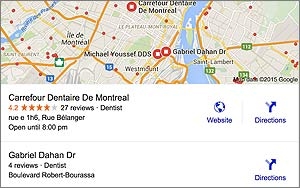Commentary
Factors Contributing To Local Mobile Search Rankings May Surprise You
- by Laurie Sullivan , Staff Writer @lauriesullivan, September 24, 2015
 What
ranks a business higher in organic local search results, and what are the negative ranking factors that drive down results? One thing is certain — behavioral signals continue to increase in
importance on mobile. Mobile signals now make up 9.5% of the algorithm across the local query results in 2015 — up from 6.9% during the same time last year, according to research released
Thursday.
What
ranks a business higher in organic local search results, and what are the negative ranking factors that drive down results? One thing is certain — behavioral signals continue to increase in
importance on mobile. Mobile signals now make up 9.5% of the algorithm across the local query results in 2015 — up from 6.9% during the same time last year, according to research released
Thursday.
Moz asked survey respondents to rate Google's "snack pack" results, a cluster of Web results aggregated from local intent queries, as well as local organic ranking factor results. Findings from the 2015 Local Search Ranking Factors are are consolidated to the top 50 in each category and divided into three ranking factors — General, Specific, and Negative — as well as Relative Change In Importance since Google implemented the change.
Before jumping into the findings, Andrew Shotland, CEO at Local SEO Guide, describes the "snack pack" as three local business listings, often connected to a Google Map, which now seem to appear at the top of the organic results for most local search queries globally.
In the survey findings of the General Ranking Factors category, Moz asked survey participants to identify the influence of eight thematic clusters of ranking factors across the two primary types of Local results: localized organic, and pack. In each case, survey participants assigned a percentage of influence to all eight thematic clusters, totaling 100%.
It turns out that on-page signals like domain authority and keywords in titles rated as the most important factor in localized organic results at 20.3% in the findings. Link signals like inbound anchor text, linking domain authority and quantity ranked No. 2 at 20%. Business signals like keywords in business titles and proximity ranked No. 3 at 14.7%.
Several factors force listing down the query. So, Moz asked experts to rank 27 negative factors in order of most damaging to most benign. The findings found Incorrect Business Categories ranked No. 1 under Negative Ranking Factors, followed by Listing Detected At False Business Address. Mismatch NAP and tacking phone Numbers, Presence of Malware on the site, and reports of Violations on GMB location round out the top three.
Since Google rolled out the snack pack on mobile, some search engine optimization professions say they focus on certain factors more, and others less. Quality/Authority of Structured Citations ranks at the top of the list for what professionals focus on more. Quality/Authority of Inbound Links to Domain follows at No. 2; Quantity of Native Google Reviews, No.3; Consistency of Structured Citations, No. 4; and Quantity of Inbound Links to Domain, No. 5.
The top five factors experts focus on less include Proximity of Address to Centroid, Quantity of Structured Citations, Authority of +1's on Website, Number of Shares on Google+, and Quantity of Citations from Industry-Relevant Domains.
The findings offer a lot of insight into the types of data and signals search engine professionals focus on today.



